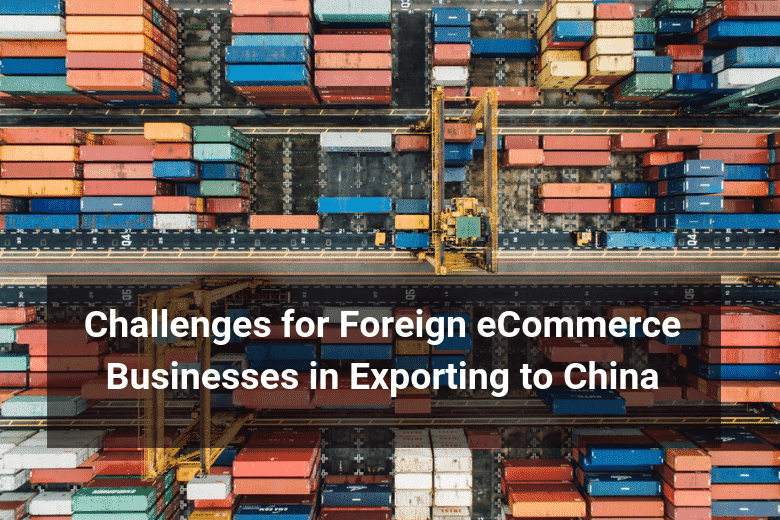For centuries, China’s huge market has attracted traders from all over the world. Now, thanks to the internet and globalization, exporting to China is easier and more profitable than ever. According to Statista, more than 650 million Chinese citizens are digital buyers and the e-commerce market is expected to keep growing at an outstanding pace in the next four years.
However, despite the advances in communication which have made transcontinental commerce easier, some challenges persist when exporting to mainland China. In this article we’ll go through some of the most common barriers that foreign e-commerce businesses encounter when exporting to China.
E-commerce law is complicated and continually evolving
Chinese government policies regulating the digital marketplace are complicated, prone to change without notice, and aren’t applied uniformly since they can sometimes come into conflict with local authorities and policies.
These types of problems can affect bonded logistic parks, were e-commerce businesses store their products until they are purchased. Foreign companies and traders need to obtain the required licenses to use the parks, but the process is long and complicated.
Having an experienced local lawyer is a must. Especially because the country’s new e-commerce law, which requires individual traders and companies to have an online certificate, is expected to come into force next year and details about the registration process haven’t been released yet.
Taxation is hard to understand and subject to the ongoing trade war with the US
Navigating through the intricacies of China’s customs and taxation system can be confusing for foreigners. Basically, any e-commerce product imported into the country should be listed in one of the Positive Lists for Cross-Border E-Commerce, where tax rates are specified for each product.
Hiring a professional advisor who can sort out import taxes and duties can help companies and individual traders to save a lot of time and money. Still, although taxation on e-commerce is more relaxed than on normal trade it doesn’t escape the consequences of the ongoing trade war with America.
The tensions between both countries could really reduce e-commerce profit margins in the future, especially if President Trump follows his threat of hitting an additional $267 billion Chinese imports with new tariffs and the Chinese government retaliates.
The marketplace model is expensive and dominates digital sales
Most Chinese people use local third-party platforms to shop online. Foreigners can sell their products through these platforms provided they are registered in the country, have local business representation, and posses warehousing arrangements.
However, selling through these platforms can be difficult for a variety of reasons. Taobao, for example, is the most popular digital market in the world and the perfect place to start for a small business. However, competition is so fierce that profit margins often suffer for the sake of making sales.
Tmall and JD, on the other hand, offer excellent brand exposure but are expensive and have more stringent rules. Companies using these platforms need to be licensed in the country and pay a security deposit of several thousand dollars before they can do business in China.
Finding a local trading partner can be a hit-or-miss affair
With thousands of miles and several time zones separating companies from their clients, having a Chinese trading partner can make all the difference when navigating through the complicated local regulations, legal processes, and language barriers.
Having a local partner is also required to make use of cross-border e-commerce bonded warehouses. Partners are a major asset for foreign companies because they allow them to operate without having to open subsidiaries or learn the intricacies of the newest rules and regulations.
However, without local contacts or previous experience in the country, most companies and traders taking their first step in the middle kingdom can end up tripping and falling repeatedly until they find the right partner.
Offline infrastructure is scarce
Despite becoming the world’s workshop, China’s physical infrastructure hasn’t kept pace with its industrial development. Few cities, other than the major ports, have the physical stores, warehouses, and roads necessary to ensure products reach consumers on time regardless of their location.
Despite the massive process of urbanization, more than 42% of the population still lives in rural areas where distribution remains an issue even in prefecture-level cities.
This infrastructure weakness is partly the reason why so many middle-class consumers have taken to the web to purchase what they want. Unfortunately, the poor infrastructure almost ensures that products arrive late and be costlier than they would if they were distributed from a local physical store.
Limited Third-Party Logistics keep distribution costs high
China is a huge but still relatively underdeveloped country. Despite the surge in online cross-border e-commerce, the country doesn’t have the logistical base necessary to reduce the costs of cross-country transportation.
To ameliorate this situation, most companies have taken to implement self-pick-up strategies or employ one of the millions of underpaid drivers in the country to provide last-mile delivery services. But despite being a simple, low-tech solution this only serves to transfer the financial burden of moving products to the consumers.
The good news is that, according to recent research, companies can reduce up to 30% of their logistical costs and improve their customers’ experience by streamlining their processes, improving their delivery routes, standardizing packaging, and tracking returned products.
Language can be a major barrier
China has been slow to adopt English as an international language. China is ranked 36th in the EF English Proficiency Index and is considered a low-proficiency country with the majority of English speakers living in urban areas like Shanghai, Hong Kong, Beijing, and Tianjin.
Mandarin Chinese is not only the language of preference for e-commerce, but companies are actually required by consumer laws to use it to provide customer support.
Even small, independent retail traders can’t escape this Great Language Wall as most government and online e-commerce platforms are written exclusively in Chinese.
Conclusion
The Chinese e-commerce market can be incredibly lucrative for those who succeed in taming it; especially now that the growing middle class is more eager than ever to acquire high-quality foreign products. However, breaking into China’s digital market isn’t as easy as it seems and demands a unique approach, as well as careful consideration of the risks and rewards in order to guarantee success.
Solution? Using a specialized Fulfillment partner!
Floship is a Hong Kong-based, tech-powered cross-border order fulfillment provider. We store, pick & pack and ship globally. We also export eCommerce parcels to mainland China. Through partnerships and our experience with exporting to China, we know exactly how to get your products to Chinese consumers in the fastest, cheapest and most reliable ways. Choosing a fulfillment provider in Hong Kong means that you benefit from Hong Kong’s 0% tax rate for imports to Hong Kong, and storage will be right at the doorstep of China. This means, faster shipping times at affordable prices.
Want to learn more? Fill out our consultation form and we will get in touch with you to discuss a tailor-made solution for your specific business needs. No strings attached! Click here to get started!
Other interesting posts around exporting to China:
Do You Really Need to Learn Mandarin for Your Export Business? Yes, You Do!
How E-Commerce Businesses Are Entering the Chinese Market Without Getting Burned

Ready To Upgrade Your Logistic Solution?
Speak to Floship ecommerce logistic consultant about improving your global support chain today




